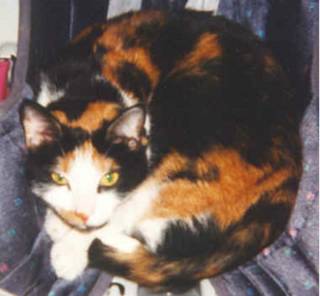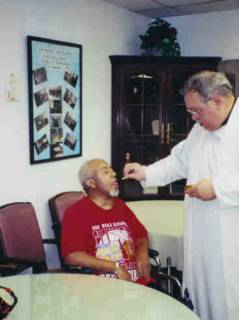Saturday, March 26, 2005
Friday, March 25, 2005
Catholicism & the Black Experience
Our Mother of Africa Chapel at the Shrine
The statue of Our Mother of Africa, holding the Christ Child, looks down upon us. She strides forward toward the narrative relief in the nave, and her Divine Son gestures for us to read the relief, which spans the African American experience from slavery to emancipation. The narrative begins with slave traders raiding an African village. They herd men, women, and children into the hole of one of the many small merchant ships active in the seventeenth and eighteenth centuries in the "triangular route" of transatlantic trade. Setting out from London, Bristol, and Liverpool, these three-masted, square-stern vessels, approximately sixty feet long, loaded with brass, pewter, woolens, East Indian textiles, arms, glass beads, and the like, traveled to the coast of West Africa.

Our Mother of Africa

Once these wares were bartered for slaves and ivory, the traders set sail for Jamaica, Barbados, South Carolina, or Virginia. In that two- to three-month trip across the Atlantic more than 200 slaves - men, women, and children - would be wedged into a hole ten feet deep and approximately twenty-three feet wide. In the New World, they were traded for cargoes of sugar, tobacco, hardwoods, indigo, and ginger bound for the return voyage to English and European markets.
At the entrance to the chapel on the floor of the nave is an abstraction in bronze relief of the Henrietta Marie, a seventeenth-century slave ship, which was discovered in 1972, thirty-four miles west of Key West, Florida. Those who survived the Middle Passage were sold at public auction into slavery. Early on, many rebelled. From the runaway slave to the Underground Railway to Canada and freedom, the courageous spirit of the African American is portrayed here. With the shackles of slavery finally broken, African Americans begin to confront prejudice and discrimination by means of Civil Rights marches, legislation, and prayer, through the inspiration of the Holy Spirit, who reigns above and dwells within. The narrative culminates in the quest for full emancipation realized in the African American family of today. The mother and father are modeled fully in the round. As if freed from the bronze of the relief, they step into the spectator's space and lift up their arms in supplication to Christ on the cross, while their young son and daughter gaze with hope across the nave to Our Mother of Africa and the Infant Jesus.
--taken from the SHRINE description.
The Catholic Church & Slavery
Despite the practice of certain churchmen, as in the United States, the voice of the Catholic Church has consistently condemned the practice of racial slavery from its very instigation. Some six decades before Columbus set out for the new world, Pope Eugene IV condemned the enslavement of black natives from the Canary Islands. This 1435 papal command demanded the European slave-masters to release them within 15 days or face the weight of excommunication from the Church. Similarly, Pope Paul III in 1537 condemned the enslavement of West Indian and South American natives. He went so far as to expressly label it as an "unheard of before now" evil that found its principal instigator in the malicious "enemy of the human race," Satan, himself.
Those who argue that the popes were in league with the slave-oppressors, do not know the facts and defame many courageous Shepherds of Rome. One after another, the spoke with one voice against the great evil of slavery: Popes Gregory XIV (1591), Urban VIII (1639), Innocent XI (1686), Benedict XIV (1741), and Pius VII (1815). Back in 1839, (21 years before the beginning of our Civil War), Pope Gregory XVI wrote without qualification: "We, by apostolic authority, warn and strongly exhort... that no one in the future dare to bother unjustly, despoil of their possessions, or reduce to slavery Indians, Blacks or other such peoples." Despite the conclusion of our War Between the States, Pope Leo XIII (1890), still had to world condemned slavery, as did the Second Vatican Council (1965). Pope John Paul II has added his voice in our day when slavery is still practiced in parts of Africa and Asia.
--researched by Lane Core.
Pierre Toussaint
The Vatican took another step recently toward declaring a Haitian-born slave, the United States' first black saint. The Vatican body which studies candidates for sainthood issued a decree recognizing that Pierre Toussaint "lived in an outstanding way, better than we do," said the Rev. Paolo Molinari, who is promoting Toussaint's sainthood. Pope John Paul II attended a ceremony at the Vatican on Tuesday to present the decree declaring the "heroic virtues" of Toussaint. "The decree means "Pierre Toussaint, more than any of us, lived...in an outstanding Christian way," Molinari said. The process of declaring official sainthood is long and complex. Candidates must first be beatified, and beatification requires a certified miracle. Molinari said several possible miracles attributed to Toussaint's intercession are under study. Toussaint worked for a well-educated, religious Catholic family in Haiti that brought him to New Yourk when they fled an anti-slavery uprising. Living with the family as a domestic servant, Toussaint learned to read and write. He also worked as a barber and was allowed to keep some earnings. After his owner died, the widow became impoverished and Toussaint supported her. The widow freed him before she died in 1807. Toussaint then married a woman from Haiti. Until his death in New York City in 1853, he worked with orphans, the poor and the sick, both black and white, Molinari said.
--taken from Catholic ONLINE Black Saints Index.
St. Martin De Porres
On May 16, 1962, Pope John XXIII, in a ceremony at St. Peter's Basilica in Rome, made Martin de Porres the first black saint of the Americas. Born on Dec. 9, 1579, in Lima Peru, he was the illegitimate son of Don Juan de Porres of Burgos, a Spanish nobleman, and Ana Velasquez, a young freed black slave girl. From early childhood, he showed great piety, a deep love for all God's creatures, and a passionate devotion to Our Lady. At eleven he took a job as servant in the Dominican priory and worked with such devotion that he was called "the Saint of the Broom." Promoted to an almoner, he soon was begging more than $2,000 a week from the rich. Everything was given to the poor and sick of Lima in the form of food, clothing or medicine. Martin was charged with the infirmary where he became known for his tender care of the sick and for spectacular cures. In recognition of his fame and deep devotion, his superiors dropped the stipulation that "no black person may be received to the holy habit or profession of our order." Martin was vested in the full habit and took his solemn vows as a Dominican brother.
As a Dominican, he became more devout and desirous to serve. He established an orphanage and a hospital for the poor slum children. He even set up a caring shelter for the stray cats and dogs. Martin lived a self-imposed austerity. He never ate meat; he fasted continuously; and spent much time in prayer and meditation. Venerated from the day of his death, many miraculous cures were attributed to him, including the raising of the dead. Today, throughout South America, Central America and the islands of the Caribbean, people tell of his miraculous powers.
--taken from Catholic ONLINE Black Saints Index.
Kitty Nottingham, Parishioner & Staff

Kitty is on Staff, Works for Cat Food

Miss Kitty Kat Nottingham recently registered as a parishioner at the Church of the Holy Spirit. Last year she offered a small donation ($1) to the Cardinal's Stewardship Appeal. She is partial to sparrows but she is willing to give cardinals a try-- yum!
She has a somewhat violent and tempermental way about her and is usually kept apart from people to whom she might do damage. But even though she has a heart black as coal, she is a good mouser and thus earns her keep.
She is not much for answering phone calls, although she does take faxes and can sometimes be found on the typewriter.








